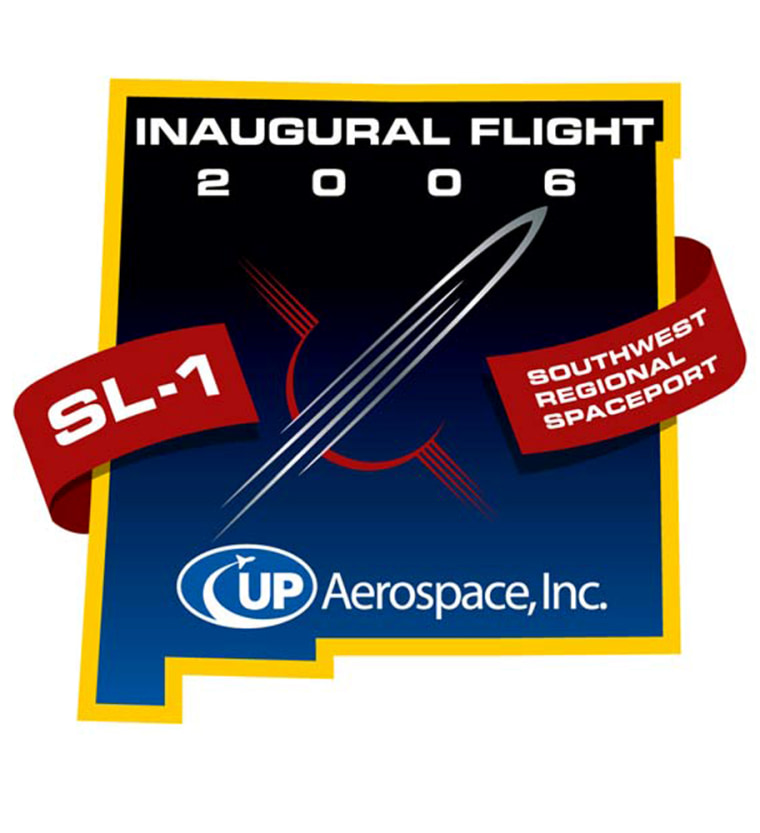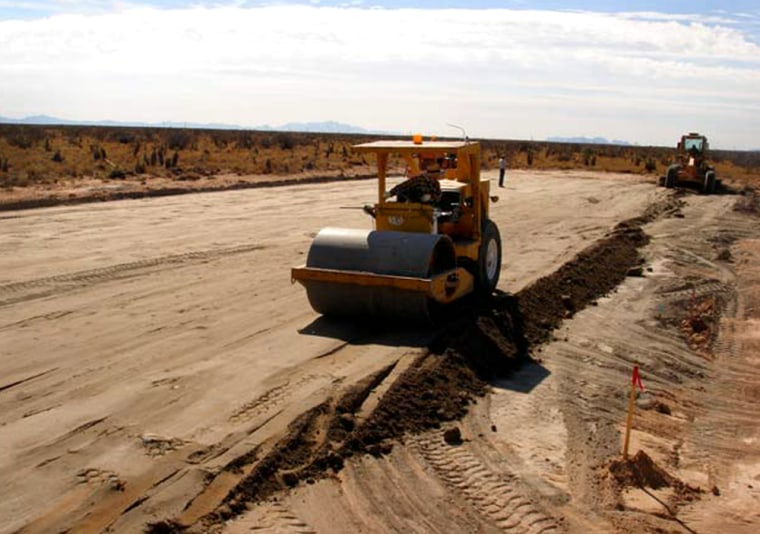Work is under way to prepare for the inaugural rocket blastoff from New Mexico's spaceport. Concrete is being poured, and a pad and its associated infrastructure are being put into place — essentially bringing the spaceport to life.
Meantime, the UP Aerospace SpaceLoft XL is being readied for its suborbital mission from the southeast section of the spaceport, designated for vertically launched rockets.
“A major milestone has been reached in the spaceport's construction,” said Jerry Larson, president of Connecticut-based UP Aerospace. The center section of the launch pad has been poured, which will anchor a multi-ton rocket launcher. The remainder of the launch pad will be poured by the end of this month, Larson told Space.com.
A hydraulically controlled rocket launch rail, weighing 7 tons and standing 56 feet (17 meters) tall, has been transported to New Mexico. “Once in place, it will be visible for miles around,” Larson said.
Larson said the on-site launch facilities will include a Launch Control Center building, the Payload Assembly and Integration building, the mobile Vehicle Assembly Building — which rolls on top of the concrete launch pad — and a high-tech Doppler “SODAR” (Sonic Detection and Ranging) weather station.
The New Mexico spaceport site is approximately 27 square miles (70 square kilometers) of open, generally level range land, 45 miles (72 kilometers) north of Las Cruces and 30 miles (48 kilometers) east of Truth or Consequences. This location was favored for its low population density, uncongested airspace and high elevation.
New Mexico Economic Development Secretary Rick Homans, who is also chairman of the New Mexico Spaceport Authority, said last month that the UP Aerospace launch from the spaceport property was targeted for mid-May.
University payloads
When the SpaceLoft XL climbs into the sky, it will be packed with a set of creative payloads, said Eric Knight, chief executive officer for UP Aerospace.

New Mexico State University is testing a vehicle attitude sensor that will be used in the design of a “nanosat” satellite, Knight told Space.com. Students at the University of Colorado at Boulder and the Colorado Space Grant Consortium have developed a payload to measure and record the microwave radiation levels and cosmic rays during the suborbital flight.
And students at Brown University in Rhode Island, in conjunction with engineers at AeroAstro Inc., have developed a research package that includes a prototype star tracker and data logger. Also on board the rocket is a Central Connecticut State University research package that includes a variety of thermocouples to analyze and record the characteristics of the space environment.
Then there’s the University of Hartford testing of a vapor phase catalytic ammonia removal system. That technology represents the next generation in water recovery for human spaceflight missions, Knight noted.
Entrepreneurial packages
In addition, more than 40 experiments from high-school students from across America are to be flown.
To open the space-access door to students at this level, Knight said that UP Aerospace has partnered with the Connecticut Center for Advanced Technology and the National Aerospace Leadership Initiative. These organizations have established “LaunchQuest,” a program that lets youngsters conduct their own spaceflight research.
On the commercial side, a number of firms from the United States and Europe are on the flight. Due to confidentially agreements, Knight can’t offer too much detail on these entrepreneurial payloads.
From launch to landing
The SpaceLoft XL is a single-stage, solid-propellant rocket.
Blasting off from its New Mexico spaceport pad, the rocket will accelerate to five times the speed of sound — nearly 3,400 miles per hour (5,440 kilometers per hour) — in just 13.5 seconds, Larson said. It will reach the international definition of space, 62 miles or 100 kilometers, in just a minute and a half, and achieve a flight apogee of about 70 miles (113 kilometers) shortly thereafter, he said.
The mission includes support from White Sands Missile Range, located east of the spaceport. The SpaceLoft XL rocket includes a transponder that will be tracked by the radars at White Sands, providing the highest-quality data possible for use in obtaining a spaceport license from the Federal Aviation Administration, Larson explained.
As the rocket arcs over and begins its return from space, it will separate into two sections: an upper nosecone/payload section and a lower rocket booster section.
Both rocket components are to be recovered by parachutes approximately 33 miles (53 kilometers) away from takeoff, touching down on the White Sands Missile Range. The entire flight from launch to landing will take about 15 minutes.
Work ahead before thumbs-up
The goal is for launch site buildings to be in put in place mid-April, Larson said.
“We’ll then begin our site activation and vehicle pathfinder activities at the spaceport. Computers will be brought in, cables run. Communication systems, both wired and wireless, will be set up,” Larson stated. “There’s a lot of work to do before a space launch can be conducted.”
Regarding the launch date, it’s still a few months away, Larson continued. Testing of the entire launch facility and the rocket’s systems must be done before UP Aerospace gives the thumbs-up for the mission, he said.
“We want to make sure the launch and recovery are absolutely flawless,” Larson said.
